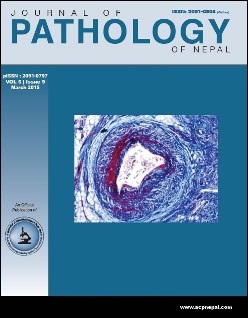Expressions of HPV 16-E6 in esophageal carcinoma and it’s clinical significance
DOI:
https://doi.org/10.3126/jpn.v5i9.13786Keywords:
Esophageal carcinoma, HPV 16-E6, ImmunohistochemistryAbstract
Background?Gastrointestinal cancer is the most common malignant tumor in China. This research aims to explore the association between HPV16-E6 protein and esophageal squamous cell carcinoma.
Materials and Methods: SP immunohistochemical method was used to examine the expression of HPV 16-E6 in 50 cases of esophageal squamous cell carcinoma, 10 cases of normal esophageal squamous cell and 10 cases of adjacent tissue.
Results: The expressions of HPV 16-E6 was significantly higher in esophageal carcinoma than in normal esophageal mucosa and in adjacent tissue. The expressions of HPV 16-E6 had correlation with invasive depth (P<0.05), but not with patient age, lymph node metastasis, tumor size (P>0.05).
Conclusion: HPV 16-E6 can promote the growth and metastasis of esophageal squamous cell carcinoma and can be a prognostic factor of esophageal squamous cell carcinoma.
Journal of Pathology of Nepal (2015) Vol. 5, 752-755
Downloads
Downloads
Published
How to Cite
Issue
Section
License
This license enables reusers to distribute, remix, adapt, and build upon the material in any medium or format, so long as attribution is given to the creator. The license allows for commercial use.




